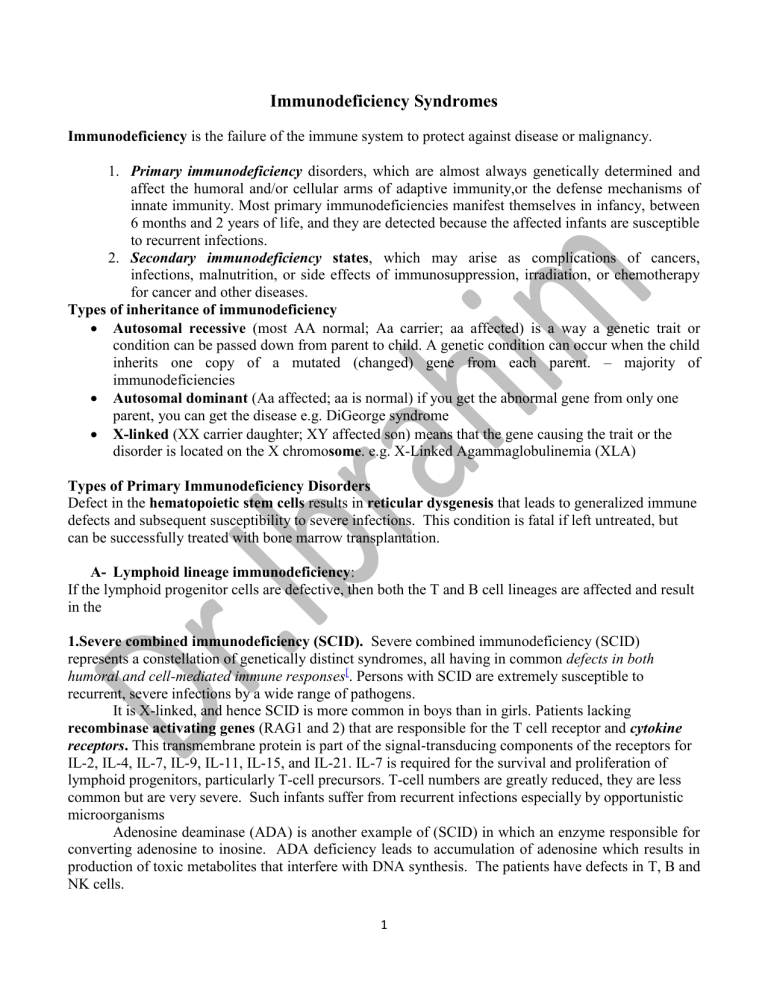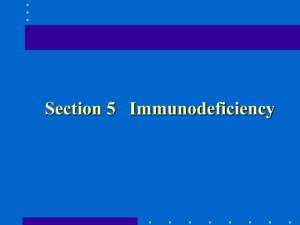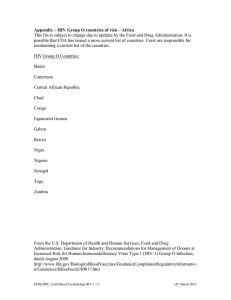
Immunodeficiency Syndromes Immunodeficiency is the failure of the immune system to protect against disease or malignancy. 1. Primary immunodeficiency disorders, which are almost always genetically determined and affect the humoral and/or cellular arms of adaptive immunity,or the defense mechanisms of innate immunity. Most primary immunodeficiencies manifest themselves in infancy, between 6 months and 2 years of life, and they are detected because the affected infants are susceptible to recurrent infections. 2. Secondary immunodeficiency states, which may arise as complications of cancers, infections, malnutrition, or side effects of immunosuppression, irradiation, or chemotherapy for cancer and other diseases. Types of inheritance of immunodeficiency Autosomal recessive (most AA normal; Aa carrier; aa affected) is a way a genetic trait or condition can be passed down from parent to child. A genetic condition can occur when the child inherits one copy of a mutated (changed) gene from each parent. – majority of immunodeficiencies Autosomal dominant (Aa affected; aa is normal) if you get the abnormal gene from only one parent, you can get the disease e.g. DiGeorge syndrome X-linked (XX carrier daughter; XY affected son) means that the gene causing the trait or the disorder is located on the X chromosome. e.g. X-Linked Agammaglobulinemia (XLA) Types of Primary Immunodeficiency Disorders Defect in the hematopoietic stem cells results in reticular dysgenesis that leads to generalized immune defects and subsequent susceptibility to severe infections. This condition is fatal if left untreated, but can be successfully treated with bone marrow transplantation. A- Lymphoid lineage immunodeficiency: If the lymphoid progenitor cells are defective, then both the T and B cell lineages are affected and result in the 1.Severe combined immunodeficiency (SCID). Severe combined immunodeficiency (SCID) represents a constellation of genetically distinct syndromes, all having in common defects in both humoral and cell-mediated immune responses[. Persons with SCID are extremely susceptible to recurrent, severe infections by a wide range of pathogens. It is X-linked, and hence SCID is more common in boys than in girls. Patients lacking recombinase activating genes (RAG1 and 2) that are responsible for the T cell receptor and cytokine receptors. This transmembrane protein is part of the signal-transducing components of the receptors for IL-2, IL-4, IL-7, IL-9, IL-11, IL-15, and IL-21. IL-7 is required for the survival and proliferation of lymphoid progenitors, particularly T-cell precursors. T-cell numbers are greatly reduced, they are less common but are very severe. Such infants suffer from recurrent infections especially by opportunistic microorganisms Adenosine deaminase (ADA) is another example of (SCID) in which an enzyme responsible for converting adenosine to inosine. ADA deficiency leads to accumulation of adenosine which results in production of toxic metabolites that interfere with DNA synthesis. The patients have defects in T, B and NK cells. 1 2. T cell deficiency affects not only cell-mediated immunity but also humoral immunity. The patients are susceptible to viral, protozoal and fungal infections as well as to intracellular bacterial infections. Infection with attenuated vaccines such as measles can also be life-threatening in these patients. DiGeorge Syndrome or congenital thymic aplasia patients lack a thymus. This deficiency results from deletion of a region on chromosome 22 during development of 3rd and 4th pharyngeal pouch. Because of this, this deficiency is also responsible for facial and heart defects. This is an autosomal dominant trait. Treatment is with a thymic graft. 3. B cell deficiency may result from the absence of B cells, plasma cells, total Igs or selective Igs. These patients have recurring infections with extracellular bacteria, but are capable of eliciting an immune response against intracellular bacteria as well as viruses and fungi. a. X-linked Agammaglobulinemia (X-LA): In such patients, mature B cells are absent as they exist in the pre B cell stage with H chains rearranged but not L chains. They also have no Igs and suffer from recurrent bacterial infections. The disease usually does not become apparent until about 6 months of age, as maternal immunoglobulins are depleted. In most cases, recurrent bacterial and viral infections of the respiratory tract. The classic form of this disease has the following characteristics: B cells are absent or markedly decreased in the circulation, and the serum levels of all classes of immunoglobulins are depressed. Plasma cells are absent throughout the body. T cell–mediated reactions are normal. b. X-linked hyper-IgM Syndrome: Such patients exhibit deficiency in IgG, IgA and IgE but have elevated IgM levels. This is due to a defect in the differentiation of IgM producing cells to cells producing other Igs. c. Selective Deficiency of Ig classes: IgA deficiency results from a defect in the class switching. Such patients suffer from respiratory and genitourinary tract infections. B. Myeloid Lineage deficiency: This deficiency involves myeloid progenitor cells and affects innate immunity. In as much as, phagocytosis is affected, the patients are susceptible to bacterial infections. 1. Congenital Agranulomatosis: Patients have a decrease in the neutrophil count. It is due to a defect in the myeloid progenitor cell differentiation into neutrophils. These patients are treated with granulocyte-macrophage colony stimulating factor (GM-CSF) or granulocyte colony stimulating factor (G-CSF). 2. Chronic Granulomatous Disease (CGD): 2 This is characterized by defective reactive oxygen species (ROS) production which normally kills phagocytosed bacteria. However, the patients do exhibit inflammatory reaction with neutrophils, macrophages and T cells resulting in the formation of granulomas. This is an autosomal recessive or X-linked trait. Treatment is with interferon- (IFN-. Complement defects: Defects in C’ components also results in immunodeficiency. As extracellular bacterial infections are eliminated by specific Abs that can fix C’, patients with C’ deficiency are susceptible to such infections. The primary immunodeficiencies are inherited in a Mendelian fashion. While majority of the diseases are autosomal recessive, some are X-linked (e.g. X-LA; X-linked hyper-IgM syndrome) or autosomal dominant (DiGeorge syndrome). Acquired or Secondary Immunodeficiencies: All acquired immunodeficiencies have been outdone by the AIDS that is caused by Human Immunodeficiency Virus (HIV)-1. It was first discovered in 1981 and the patients exhibited fungal infections with opportunistic organisms such as Pneumocystis carinii and in other cases, with a skin tumor known as Kaposi sarcoma. HIV is spread through homosexual and promiscuous heterosexual intercourse, infected blood and body fluids as well as from mother to offspring. It is a retrovirus with RNA that is reverse transcribed to DNA by reverse transciptase (RT) following entry into the cell. The DNA is integrated into the cell genome as a provirus that is replicated along with the cell. The virus attaches to the CD4 molecule on human Th cells, monocytes and dendritic cells through the gp120 of HIV. For HIV infection, a coreceptor is required. The coreceptor for HIV is a chemokine receptor such as CXCR4 or CCR5. The M-tropic strain of HIV requires CCR5 expressed predominantly on macrophages while the T-tropic strain requires CXCR4 on CD4+ T cells to serve as coreceptors for HIV infection. After the fusion of HIV envelope and the host membrane, the nucleocapsid enters the cell. The RT synthesizes viral DNA which is transported to the nucleus where it integrates with the cell DNA in the form of a provirus. The provirus can remain latent till the cell is activated when the provirus also undergoes transcription. Immunological Changes: The virus replicates rapidly and within ~2 weeks the patient develops fever. The viral load in the blood increases significantly and peaks in ~2 months after which there is a sudden decline because of the latent virus found in germinal centers of the lymph nodes. Cytotoxic T cells (CTL) develop very early whereas antibodies can be detected between 3-8 weeks. In addition to the direct killing of the CD4+ T helper (Th) cells by HIV, the CTL may also kill the infected CD4+ T cells which results decrease in CD4+ T cells around 4-8 weeks. When the CD4+ T cell count decreases below 200/mm3, full blown AIDS develops. 3



